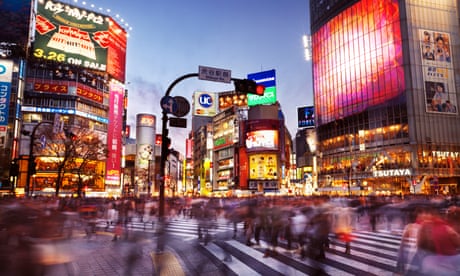can follow HK system
How public transport actually turns a profit in Hong Kong
This article is more than
3 months old
The Hong Kong MTR’s ‘rail plus property’ model keep fares cheap and makes the company completely self-sustaining. Could loss-making metro systems in other cities learn lessons?
Cities is supported by
 About this content
Matthew Keegan
About this content
Matthew Keegan in Hong Kong
Tue 19 Mar 2019 18.00 AEDTLast modified on Tue 19 Mar 2019 18.02 AEDT
Shares
385
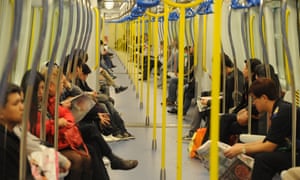
“Once we build the railway, the value of land rises and we capture the increase in value,” says Jacob Kam, managing director and soon-to-be chief executive, of Hong Kong’s Mass Transit Railway (MTR) Corporation.
Hong Kong faces commuter chaos after rare train collision
Read more
This “rail plus property” model allows Hong Kong’s public transport company to be self-financing – unlike most of its counterparts around the world, many of which are loss-making and need to be subsidised by government. This month
MTR Corporation reported a net profit for 2018 of HK$16.01bn (£1.6bn).
Civic Square, part of a sprawling outdoor development above Kowloon Station, shows the model in action. The 118-storey skyscraper, luxury shopping mall, 6,300 flats and two five-star hotels that sit above the station were all developed or are now owned and managed by the MTR.
If we design well, plan well and build well then we get that increase in value
Incoming CEO Jacob Kam
The MTR makes just as much profit above ground, from property developments, as it does from rail operations, making it one of the most profitable metro operators in the world.
At a time when rail services in cities globally continue to draw the ire of passengers for disruptions, delays and fare increases, the MTR manages an almost perfect 99.9% on-time rate while carrying an average of 5.8 million passengers daily. Fares are kept relatively low, ranging from HK$4 (40p) to HK$59.50 (£5.80), but nevertheless cover 170% of the system’s operating costs. The cheapest will take you a few stops, the most expensive the entire length of the city.
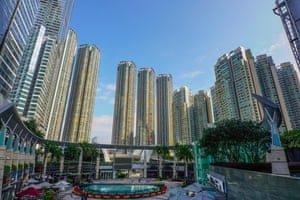
Civic Square in West Kowloon. The shopping mall, apartments and two five-star hotels were all developed or are now owned and managed by the MTR. Photograph: Photogenic/Alamy
Could loss-making metro systems in other cities learn lessons? Transport for London covers only £4.8bn of its £10.2bn budget from revenue, according to
figures on its website, and the New York City subway spends $2.6bn (£1.9bn) annually just to service its debt.
Sign up for the Cityscape: the best of Guardian Cities every week
Read more
Karol Zemek, editor of Metro Report International, sounds a note of caution. “It is worth remembering that the metro in
Hong Kong is much younger than those in London and New York,” he says. “A lot of problems, especially in New York at the moment, come from ageing infrastructure. Parts of the London and New York networks are among the oldest examples of metros in the world.”
Advertisement
The MTR’s model is made possible by the Hong Kong government. “The government gives us the land and development rights for the greenfield price – the price of the land before the railway is built,” says Kam, who will become CEO in April when incumbent Lincoln Leong
retires early after a scandal over construction of the HK$97.1bn Sha Tin-Central line. The government is also the MTR’s majority shareholder.
The model sees the MTR construct the new rail line and tender for private developers to build residential and commercial properties above its stations, then take a share of the resulting sale or rental income. This provides the capital for operations and maintenance as well as for funding new projects.
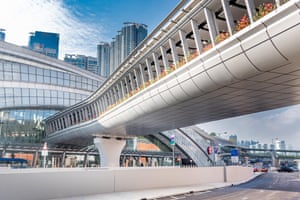
Hong Kong’s West Kowloon Station connects to mainland China. Photograph: MEMEME/Alamy
Advertisement
For example, revenues from developments along MTR’s Tseung Kwan O line, opened in 2002, financed the extension of that line to serve a new town that has since grown to a population of 380,000. Crucially, the model also spares the MTR from having to compete with every other public agency for state funding, allowing it to be self-sustaining and implement rail projects relatively quickly.
Since the MTR’s first “rail plus property” development in 1980, the model has been expanded extensively throughout the city. In total, MTR manages 47 developments above its 93 stations and depots. In 2018, its property management and rental in Hong Kong generated revenue of HK$5bn, with property development turning a pretax profit of HK$2.57bn.
In addition to being a successful source of income, Kam says the model improves the city’s urban development. “The model gives us the incentive to make good use of the land,” he says. “If we design well, plan well and build well, then we get that increase in value.”
The result is what are often high-quality living environments with seamless transport connections. The Kowloon Station development has at least six uses of land: rail, a bus interchange, retail, residential, hotels and offices.
“No matter how much land you have in rural areas, you don’t have enough land in cities,” Kam says. “So a lot of city officials are now finding that it’s actually very useful to make multiple use of land this way. Using the transport network, especially the railway network, they can increase the intensity of development, making land use in cities much more efficient.”
But all does not run smoothly. The MTR’s property development model has come under fire for building private instead of public housing to maximise profits. Critics say contracts to build property over stations should be open to tender and not just given to the MTR.
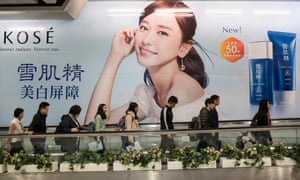
Commuters at an MTR station. Photograph: SOPA Images/LightRocket via Getty Images
Advertisement
“While the ‘rail plus property’ model is somewhat positive for financial sufficiency and urban modernisation, we must admit that there are ongoing issues of housing affordability and income disparity around stations,” says Jin Murakami, a city planner and academic researcher. “This was not programmed in the model originally and is something Hong Kong citizens are increasingly concerned about.”
Hong Kong’s former transport and housing minister Anthony Cheung Bing-leung last year urged the government not to grant MTR property development rights at new stations. He feels the MTR’s construction of only private housing makes it difficult to meet public housing targets. “To be fair they should be open for tender,” he told the South China Morning Post. “The government should not favour one company only, unless the company always thinks of the public interest.”
'A race against time': urban explorers record vanishing Hong Kong
Read more
The MTR says it is attempting to address this criticism. A number of new schemes the MTR is discussing could involve the government assigning 30% of new residential properties to public housing, with 70% private. “Some would prefer it the other way round, with 30% private and 70% public,” says Kam. “But that would result in the private housing being extremely expensive.” Either way, Kam says it is within the government’s power to make this happen. “There is no theoretical barrier why we cannot have mixed development on top of stations and depots.”
The MTR is now keen to export its sustainable rail and urban development model around the world.
“If cities want a sustainable railway, they will need to resolve the loss-making issues that plague so many of them,” says Kam. “Each country has a different land policy, so they might not be able to implement ‘rail plus property’ in the same way that we do in Hong Kong, but they are thinking about a very similar approach. We believe there are possibilities in Australia, Sweden and the UK.”
Advertisement
Follow Guardian Cities on Twitter, Facebook and Instagram to join the discussion, catch up on our best stories or sign up for our weekly newsletter
https://www.theguardian.com/cities/...ransport-actually-turns-a-profit-in-hong-kong





